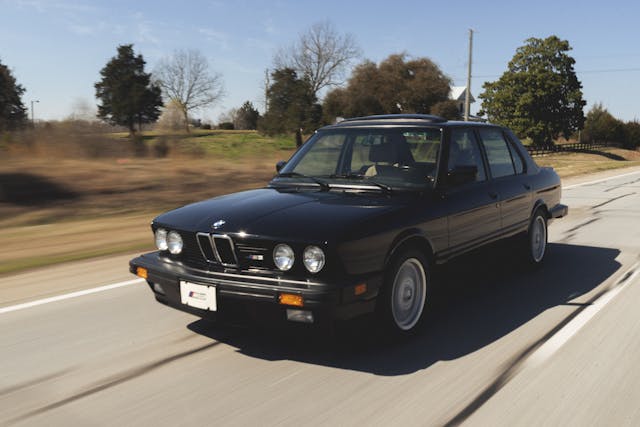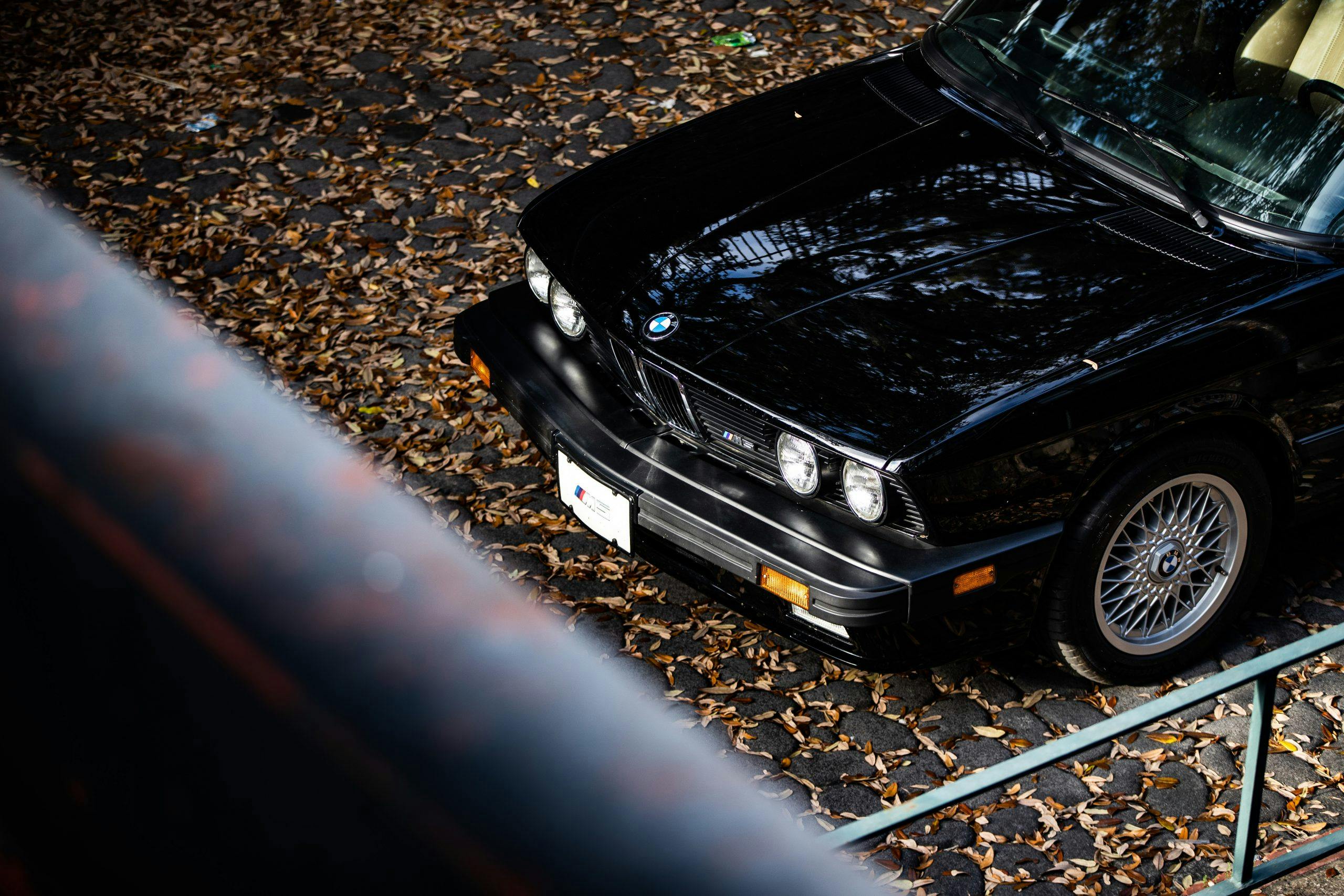Media | Articles
My old BMW M5 is the perfect example of third-owner syndrome
About ten years ago, I bought a 1988 BMW M5. One of the earliest Motorsports cars brought to the U.S., the Darth Vader black five-speed E28 M5 was part of the first wave of uber-performance sedans that stuck a shiv into the ribs of the Malaise Era. The original list price of the car was $46,500, or, about $120,000 in today’s dollars. The first owner was a doctor in Seattle, but by the time I got my grubby bottom-feeder paws on the car, it had been through two subsequent owners and had some significant needs. But in life, timing is everything, and I wound up doing just fine because of a little luck and the quirks of the collector car market.
Third-owner syndrome is now a term of art, that as nearly as I can tell, was coined by Hagerty Price Guide Publisher Dave Kinney. It describes the situation in which buyers of fully depreciated exotics can afford the initial buy-in, but when it comes to exotic car maintenance, let’s just say that more basic needs, like food and shelter expenses, divert a significant amount of cash. My M5 was a textbook example. I bought it after a phone call from my good friend, the late Paul Duchene, a longtime Hagerty contributor. It was being stored outside under a tarp somewhere in rural Oregon. He thought it probably ran, or at least would run.

As I recall, it ran well enough to get itself up on a trailer, and my all-in price for the car was about $10,000 delivered to Ann Arbor. Cosmetically, it wasn’t bad—the seats were a little dry, and the black paint was a web of swirl marks, as if the third owner had habitually wiped down the wheels and then dried the car with the same gritty towel. The seats responded to some intensive treatments, and the paint corrected just fine. Tires, calipers, fuel injectors, and a tank cleaning had the car running like a champ. None of this work was horribly pricey—I think it totaled around $4000. But for the third owner of the car, it might as well have been $40,000, or $400,000.
It’s a story that plays out frequently in the collector car world. The first owner is an obviously well-to-do individual, and if he or she is someone who trades cars frequently, owner number two (who is often only slightly less well-to-do, and perhaps even a little more savvy), can often get a nice used car with some warranty left. This person often gets the remainder of the “good” miles out of the car, finally letting it go when it’s almost fully depreciated and starting to show its age.
Enter the starry-eyed third owner, who thinks that he or she can get away with just putting in gas and oil, and maybe even DIY some of the maintenance. Then they buy a shop manual and quickly get overwhelmed at the first sight of a wiring diagram. One of three things inevitably happens—they get sick of the car taking up space and cut it loose; they put the minimal amount of money into keeping the car on the road while deferring any expensive maintenance until the can can’t be kicked any further; or they hang on long enough to actually see some appreciation.

Picking up a coveted car that’s gone through the life cycle I’ve described can be a bit of a gamble. The M5 offers a bunch of potential pitfalls: wear items, like shot front-control arms, can add up. Certain elements like the rear Self Leveling Suspension are costly on their own. Don’t get me started on engine maintenance—worn timing chain guides can cause the engine to jump timing, and trust me, you don’t want to try to find a replacement cylinder head for these cars. There was a non-zero chance that if I didn’t play my cards right and do my homework, a car like this could end up putting a hole in my wallet and have me well underwater after all was said and done.
That said, I’m a bit of an ambush predator. I’d always wanted an E28 M5. I knew that they could swallow a fair bit of cash, and the only way that this hobby has worked for me is to not lose a bunch of money whenever I move on. So I waited in the weeds for these cars to show some sign of catching on in the collector car world. That’s the key, whether for my M5 or that car you can’t get off your mind—it can take a market increase to change the economics of repairs. I got in toward the end of the low prices, got the maintenance up to snuff, enjoyed it for a while, and sold it for a few grand more than I had in it. Those are the joys of being the fourth owner. But that’s a story for another day.
***
Marketplace
Buy and sell classics with confidence
Check out the Hagerty Media homepage so you don’t miss a single story, or better yet, bookmark it. To get our best stories delivered right to your inbox, subscribe to our newsletters.






Well done! Thanks for your beneficial honesty on what one can expect from a collector car BMW or not! I’ve been that third owner a couple times. I’ve often shared with those looking at their “deal” to remember, it’s a car luxury car, if it’s a BMW or similar, therefore, it may cost (probably cost) money to get it back to specs. In addition, I’m the guy that has the mindset of while I’m replacing something, might as well do some preventative work, like I’m doing now with our Z3s cooling system. As long as the third owner understands this at the outset, it may relieve some anxiety. My two cents
@StopWhining:
Agree 100%!
Sometimes you have to do some legwork to make it through those expensive maintenance years/miles. I remember when my Audi A8 needed a fuel pump, the going price was over $1K for the part alone. Some well-invested time researching on the internet led me to a Bosch part that was exactly the same, shipped by 2-day air from the UK for about 1/3 the price. The next owner can thank me that they could go a lot of miles without fuel pump trouble. 😁
Interesting analysis, Mr Sass, and so very true. Didn’t some of us covet that ratty primer grey early 70s Corvette in high school just so we could HAVE one? Glad I avoided that!
So, reading this I realize I am that third owner, but I bought it in 1985. I am now rebuilding and reassembling all the systems on my ’67 Alfa Duetto Spider, because they’re tired, and I am the one who deferred the maintenance all those years. Drove it to work every day, parked it outside all day, went on tours. Always reliable, it just got to be 50 years old.
When it comes out of the garage, it will need Hagerty Insurance! I will drive it through the mountains like Tom in his Cobra!
The M5 was a wonderful sedan from back in the day. I miss the old BMW.
I’m the third owner of two Jags, an 05 XJR and an 06 XK8 Convertible. I wouldn’t be able to have either of I didn’t know how to do the work myself. That said I enjoy them thoroughly and knew what I was getting into. I recently thought I should have a V8 Quattroporte just once before electric takes over the world. Before I pulled the trigger I looked up what the brake parts cost and realized I would be frustrated all the time. You definitely have to do your research and as I’ve read here many times “buy the best example you can for the money you have”.
BMW, MB, and the list of new(ish) British cars dot the landscape of repair shops. I personally know of two, one if Toledo Ohio and one in Fort Wayne In with at least 20 examples of decent appearing big $$ cars. Then you look closely, dead air suspension, broken motors, odd electrical problems. I am not the first person to point out don’t buy a five year old “driver” BMW, Jaguar, or MB. The craziest point is these vehicles turn out to be throw a way’s while a mundane 2005 Chevy Impala lives on. Stranger yet, if you want to be green don’t buy a Benz!
Third owner syndrome. WOW does that ring a bell in the old car hobby. Many folks can’t afford a correctly restored old car, but they find a worn out bondo rust bucket with a shiny paint job that is inexpensive TO BUY! These optimistic folks soon get on forums asking for help because the car’s bondo is peeling off, the car won’t start, run well, or the electrical items fail. When they get responses about repair costs they are beside themselves and the car is either sold for cheap, or it sits in the garage to be “restored some day”.
I laugh when I hear people complain about repairs on old cars and not wanting to have more money in a car than it is worth. If you are worried about always making money, look into mutual funds.
Nothing quite as expensive as a “cheap” BMW! Lol
I bought a 2008 BMW 330i convertible with 110K miles. Gorgeous car, fast, great sounding exhaust, then it started leaking oil. My mechanic said the pan gasket had failed, big disassembly to get at it and by the way, there was something else down there that would need the same disassembly. Next thing was the top cover gasket, then a squigly water hose. the final straw was the air conditioner. A friend loved the car and wanted to buy it. I told him what I had replaced already. His mechanic asked him about the gaskets, water hose and air conditioner. My friend said it was done. His mechanic said BUY IT! He got a good deal and I bought a Lexus.
Golden rules: Only buy what you like. Quick ROI is super rare. Never buy if lack of service documentation, always invest in a pre-purchase inspection. It can be hard; but always see it with your eyes! Rather lose the cost of a plane ticket than 5 digits of hidden costs. My level of quality is quite different than most. I’m sure yours is as well. Know what you got and what your about to live with.
Bought my 88 M5 for <$20k, sold it for more, way too much car for American roads, especially avoiding the redneck drivers who fail to use their signal, don't stay right, can't hold their line, and play with their phone or idiot screen while not driving. I miss Germany!
Top Gear season 17 episode 3. Old luxury cars vs new econobox. All you need to know.
I’m sure many of you will issue death threats but most of those RWD cars can be taken care of for little money. Various companies sell LS swap kits. Holley make complete EFI and computer bits, which also take care of the mess of wiring under the hood. The GM transmission can be used as well, same process. A nice little BMW 357 can be yours in a weekend with ALL the required parts on hand.
Most German cars are a box full of relays. Determine the Bosch part number and pay a tenth of the price.
The body structure is the only thing that can cost mega dollars. Everything else can be manufactured with parts from Rock Auto.
Back in the day I owned a 2nd hand 1977 BMW 320i for 5 years (78-84).
All I ever heard was BMW = Big Money Waster.
I neglected it. Bad owner, today sorry I sold it.